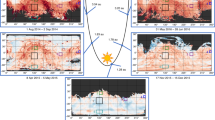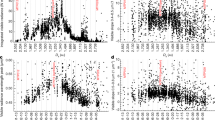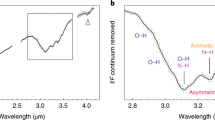Abstract
Knowledge of the surface temperature distribution on a comet’s nucleus and its temporal evolution at different timescales is key to constraining its thermophysical properties and understanding the physical processes that take place at and below the surface. Here we report on time-resolved maps of comet 67P/Churyumov–Gerasimenko retrieved on the basis of infrared data acquired by the Visible InfraRed and Thermal Imaging Spectrometer (VIRTIS) onboard the Rosetta orbiter in 2014, over a roughly two-month period in the pre-perihelion phase at heliocentric distances between 3.62 and 3.31 au from the Sun. We find that at a spatial resolution ≤15 m per pixel, the measured temperatures point out the major effect that self-heating, due to the complex shape of the nucleus, has on the diurnal temperature variation. The bilobate nucleus of comet 67P also induces daytime shadowing effects, which result in large thermal gradients. Over longer periods, VIRTIS-derived temperature values reveal seasonal changes driven by decreasing heliocentric distance combined with an increasing abundance of ice within the uppermost centimetre-thick layer, which implies the possibility of having a largely pristine nucleus interior already in the shallow subsurface.
This is a preview of subscription content, access via your institution
Access options
Access Nature and 54 other Nature Portfolio journals
Get Nature+, our best-value online-access subscription
$29.99 / 30 days
cancel any time
Subscribe to this journal
Receive 12 digital issues and online access to articles
$119.00 per year
only $9.92 per issue
Buy this article
- Purchase on Springer Link
- Instant access to full article PDF
Prices may be subject to local taxes which are calculated during checkout






Similar content being viewed by others
Data availability
The VIRTIS calibrated data are publicly available through the ESA’s Planetary Science Archive (PSA) website (https://archives.esac.esa.int/psa/) and NASA’s Planetary Data System (https://pds.nasa.gov/) in accordance with the schedule established by the Rosetta project. Other data that support the plots within this paper and other findings of this study are available from the corresponding author upon reasonable request. Readers are welcome to comment on the online version of the paper.
Code availability
The code used to retrieve surface temperature values from VIRTIS-M infrared data is a direct implementation of a published method7. The code used to derive synthetic thermal images of the nucleus of comet 67P is a direct implementation of published models18,44,45,46,51. The code used to derive theoretical temperature profiles for specific locations of the nucleus of comet 67P is a direct implementation of a published model28,29.
References
Groussin, O. et al. Surface temperature of the nucleus of comet 9P/Tempel 1. Icarus 187, 16–25 (2007).
Squyres, S. W., McKay, C. P. & Reynolds, R. T. Temperatures within comet nuclei. J. Geophys. Res. Solid Earth 90, 12831–12392 (1985).
Emerich, C. et al. Temperature and size of the nucleus of comet P/Halley deduced from IKS infrared Vega 1 measurements. Astron. Astrophys. 187, 839–842 (1987).
Soderblom, L. A. et al. Short-wavelength infrared (1.3–2.6 μm) observations of the nucleus of comet 19P/Borrelly. Icarus 167, 100–112 (2004).
Groussin, O. et al. The temperature, thermal inertia, roughness and color of the nuclei of comets 103P/Hartley 2 and 9P/Tempel 1. Icarus 222, 580–594 (2013).
Coradini, A. et al. VIRTIS: an imaging spectrometer for the Rosetta mission. Space Sci. Rev. 128, 529–559 (2007).
Tosi, F. et al. Thermal measurements of dark and bright surface features on Vesta as derived from Dawn/VIR. Icarus 240, 36–57 (2014).
Coradini, A. et al. The surface composition and temperature of asteroid 21 Lutetia as observed by Rosetta/VIRTIS. Science 334, 492–494 (2011).
Keihm, S. et al. Interpretation of combined infrared, submillimeter, and millimeter thermal flux data obtained during the Rosetta fly-by of Asteroid (21) Lutetia. Icarus 221, 395–404 (2012).
Ciarniello, C. et al. Photometric properties of comet 67P/Churyumov–Gerasimenko from VIRTIS-M onboard Rosetta. Astron. Astrophys. 583, A31 (2015).
Longobardo, A. et al. Photometric behaviour of 67P/Churyumov–Gerasimenko and analysis of its pre-perihelion diurnal variations. Mon. Not. R. Astron. Soc. 469 (Suppl. 2), S346–S356 (2017).
Gulkis, S. et al. MIRO: Microwave Instrument for Rosetta Orbiter. Space Sci. Rev. 128, 561–597 (2007).
Gulkis, S. et al. Subsurface properties and early activity of comet 67P/Churyumov–Gerasimenko. Science 347, aaa0709 (2015).
Schloerb, F. P. et al. MIRO observations of subsurface temperatures of the nucleus of 67P/Churyumo–Gerasimenko. Astron. Astrophys. 583, A29 (2015).
Jorda, L. et al. The global shape, density and rotation of comet 67P/Churyumov–Gerasimenko from preperihelion Rosetta/OSIRIS observations. Icarus 277, 257–278 (2016).
Thomas, N. et al. The morphological diversity of comet 67P/Churyumov–Gerasimenko. Science 347, aaa0440 (2015).
Davidsson, B. J. R. & Rickman, H. Surface roughness and three-dimensional heat conduction in thermophysical models. Icarus 243, 58–77 (2014).
Keller, H. U. et al. Insolation, erosion, and morphology of comet 67P/Churyumov–Gerasimenko. Astron. Astrophys. 583, A34 (2015).
Marshall, D. et al. Thermal inertia and roughness of the nucleus of comet 67P/Churyumov–Gerasimenko from MIRO and VIRTIS observations. Astron. Astrophys. 616, A122 (2018).
Lagerros, J. S. V. Thermal physics of asteroids. III. Irregular shapes and albedo variegations. Astron. Astrophys. 325, 1226–1236 (1997).
Davidsson, B. J. R. et al. Interpretation of thermal emission. I. The effect of roughness for spatially resolved atmosphereless bodies. Icarus 252, 1–21 (2015).
Preusker, F. et al. Shape model, reference system definition, and cartographic mapping standards for comet 67P/Churyumov–Gerasimenko—stereo-photogrammetric analysis of Rosetta/OSIRIS image data. Astron. Astrophys. 583, A33 (2015).
Spohn, T. et al. Thermal and mechanical properties of the near-surface layers of comet 67P/Churyumov–Gerasimenko. Science 349, aab0464 (2015).
Fornasier, S. et al. Spectrophotometric properties of the nucleus of comet 67P/Churyumov–Gerasimenko from the OSIRIS instrument onboard the Rosetta spacecraft. Astron. Astrophys. 583, A30 (2015).
Vincent, J.-B. et al. Large heterogeneities in comet 67P as revealed by active pits from sinkhole collapse. Nature 523, 63–66 (2015).
Sierks, H. et al. On the nucleus structure and activity of comet 67P/Churyumov–Gerasimenko. Science 347, aaa1044 (2015).
Keller, H. U. et al. OSIRIS — The Scientific camera system onboard Rosetta. Space Sci. Rev. 128, 433–506 (2007).
De Sanctis, M. C., Lasue, J. & Capria, M. T. Seasonal effects on comet nuclei evolution: activity, internal structure, and dust mantle formation. Astron. J. 140, 1–13 (2010).
Capria, M. T., Marchi, S., De Sanctis, M. C., Coradini, A. & Ammannito, E. The activity of main belt comets. Astron. Astrophys. 537, A71 (2012).
Capaccioni, F. et al. The organic-rich surface of comet 67P/Churyumov–Gerasimenko as seen by VIRTIS/Rosetta. Science 347, aaa0628 (2015).
Quirico, E. et al. Refractory and semi-volatile organics at the surface of comet 67P/Churyumov–Gerasimenko: insights from the VIRTIS/Rosetta imaging spectrometer. Icarus 272, 32–47 (2016).
Rousseau, B. et al. Laboratory simulations of the Vis-NIR spectra of comet 67P using sub-μm sized cosmochemical analogues. Icarus 306, 306–318 (2018).
Molaro, J. & Byrne, S. Rates of temperature change of airless landscapes and implications for thermal stress weathering. J. Geophys. Res. Planets 117, E10011 (2012).
Delbo, M. et al. Thermal fatigue as the origin of regolith on small asteroids. Nature 508, 233–236 (2014).
De Sanctis, M. C. et al. The cycle of water ice on the surface of 67P/Churyumov–Gerasimenko. Nature 525, 500–503 (2015).
El-Maarry, M. R. et al. Regional surface morphology of comet 67P/Churyumov–Gerasimenko from Rosetta/OSIRIS images: the southern hemisphere. Astron. Astrophys. 593, A110 (2016).
Filacchione, G. et al. Exposed water ice on the nucleus of comet 67P/Churyumov–Gerasimenko. Nature 529, 368–372 (2016).
Filacchione, G. et al. The global surface composition of 67P/CG nucleus by Rosetta/VIRTIS. (I) Prelanding mission phase. Icarus 274, 334–349 (2016).
Ciarniello, M. et al. The global surface composition of 67P/Churyumov–Gerasimenko nucleus by Rosetta/VIRTIS. II) Diurnal and seasonal variability. Mon. Not. R. Astron. Soc. 462 (Suppl. 1), S443–S458 (2016).
Raponi, A. et al. The temporal evolution of exposed water ice-rich areas on the surface of 67P/Churyumov–Gerasimenko: spectral analysis. Mon. Not. R. Astron. Soc. 462 (Suppl. 1), S476–S490 (2017).
Barucci, M. A. et al. Detection of exposed H2O ice on the nucleus of comet 67P/Churyumov–Gerasimenko as observed by Rosetta OSIRIS and VIRTIS instruments. Astron. Astrophys. 595, A102 (2016).
Fornasier, S. et al. Rosetta’s comet 67P/Churyumov–Gerasimenko sheds its dusty mantle to reveal its icy nature. Science 354, 1566–1570 (2016).
Lethuillier, A. et al. Analysis of observations of the Imhotep region of 67P/C-G performed by MIRO/Rosetta in 2014 and 2016 and derived constraints on the close subsurface properties. In American Astronomical Society, DPS Meeting 49 415.03 (2017).
Skorov, Yu. & Blum, J. Dust release and tensile strength of the non-volatile layer of cometary nuclei. Icarus 221, 1–11 (2012).
Skorov, Yu. V., Lieshout, R. V., Blum, J. & Keller, H. U. Activity of comets: gas transport in the near-surface porous layers of a cometary nucleus. Icarus 212, 867–876 (2011).
Gundlach, B., Skorov, Yu. V. & Blum, J. Outgassing of icy bodies in the Solar System—I. The sublimation of hexagonal water ice through dust layers. Icarus 213, 710–719 (2011).
Zinzi, A. et al. The SSDC contribution to the improvement of knowledge by means of 3D data projections of minor bodies. Adv. Space Res. 62, 2306–2316 (2018).
Lagerros, J. S. V. Thermal physics of asteroids. IV. Thermal infrared beaming. Astron. Astrophys. 332, 1123–1132 (1998).
Davidsson, B. J. R., Gutiérrez, P. J. & Rickman, H. Physical properties of morphological units on comet 9P/Tempel 1 derived from near-IR Deep Impact spectra. Icarus 201, 335–357 (2009).
Giese, B. & Kührt, E. Theoretical interpretation of infrared measurements at Deimos in the framework of crater radiation. Icarus 88, 372–379 (1990).
Capria, M. T. et al. How pristine is the interior of the comet 67P/Churyumov–Gerasimenko? Mon. Not. R. Astron. Soc. 469 (Suppl. 2), S685–S694 (2017).
Acton, C. H. Ancillary data services of NASA’s navigation and ancillary information facility. Planet. Space Sci. 44, 65–70 (1996).
Grün, E. et al. Development of a dust mantle on the surface of an insulated ice-dust mixture: results from the KOSI-9 experiment. J. Geophys. Res. 98, 15091–15104 (1993).
Acknowledgements
The authors thank the following institutions and agencies, which supported this work: Italian Space Agency (ASI-Italy), Centre National d’Etudes Spatiales (CNES-France), Deutsches Zentrum für Luft- und Raumfahrt (DLR-Germany), National Aeronautic and Space Administration (NASA-USA). VIRTIS was built by a consortium from Italy, France and Germany, under the scientific responsibility of IAPS, Istituto di Astrofisica e Planetologia Spaziali of INAF, Rome, Italy, which led also the scientific operations. The VIRTIS instrument development for ESA has been funded and managed by ASI, with contributions from Observatoire de Meudon financed by CNES and from DLR. The VIRTIS instrument industrial prime contractor was former Officine Galileo, now Leonardo SpA in Campi Bisenzio, Florence, Italy. The authors thank the Rosetta Liaison Scientists, the Rosetta Science Ground Segment and the Rosetta Mission Operations Centre for their support in planning the VIRTIS observations. We also thank the MIRO science and MIRO archiving teams for making MIRO data available to us before their public release. This research has made use of NASA’s Astrophysics Data System. D.K. acknowledges DFG-grant KA 3757/2-1. This work is dedicated to Angioletta Coradini (1946–2011), conceiver of the VIRTIS instrument, and to Sergio Fonti (1945–2018), co-author of this Article and active contributor in the development of VIRTIS. The first author dedicates this work also to Luca Malagutti (1965–2017), who was a brilliant researcher at the University of Milan.
Author information
Authors and Affiliations
Contributions
F.T. carried out the surface temperature retrieval from VIRTIS-M infrared data, derived geometric information for those data, and led the analysis of VIRTIS-measured temperature data, writing major sections of the main text and Methods. F.C. is the principal investigator of the VIRTIS instrument; he designed the overall study and wrote part of the main text. S.M., M.T.C. and M.F. carried out the thermophysical modelling and wrote part of the Methods. M.C. led the spectrophotometric analysis and derived the single scattering albedo values. G.F. was responsible for the VIRTIS calibration pipeline and flagged the saturated spectral pixels. M.H. is the principal investigator of the MIRO instrument; he granted MIRO data calibrated with the latest responsivity function, and provided key information for their proper interpretation. F.C., G.F., S.E., D.B.-M. and C.L. planned VIRTIS observations. S.E. and G.A. are respectively the French and German group leaders within the VIRTIS Science Team. The other authors are all VIRTIS co-investigators and associates who participated in the study and/or reviewed the manuscript, providing edits, comments and suggestions that led to substantial improvement of the paper.
Corresponding author
Ethics declarations
Competing interests
The authors declare no competing interests.
Additional information
Journal peer review information: Nature Astronomy thanks Ben Rozitis and the other anonymous reviewer(s) for their contribution to the peer review of this work.
Publisher’s note: Springer Nature remains neutral with regard to jurisdictional claims in published maps and institutional affiliations.
Supplementary information
Supplementary Information
Supplementary Figs. 1–8 and Supplementary Tables 1–3.
Rights and permissions
About this article
Cite this article
Tosi, F., Capaccioni, F., Capria, M.T. et al. The changing temperature of the nucleus of comet 67P induced by morphological and seasonal effects. Nat Astron 3, 649–658 (2019). https://doi.org/10.1038/s41550-019-0740-0
Received:
Accepted:
Published:
Issue Date:
DOI: https://doi.org/10.1038/s41550-019-0740-0
This article is cited by
-
The Comet Interceptor Mission
Space Science Reviews (2024)
-
Identification and characterization of a new ensemble of cometary organic molecules
Nature Communications (2022)
-
Cometary Nuclei—From Giotto to Rosetta
Space Science Reviews (2020)
-
Cometary Comae-Surface Links
Space Science Reviews (2020)
-
The Thermal, Mechanical, Structural, and Dielectric Properties of Cometary Nuclei After Rosetta
Space Science Reviews (2019)



